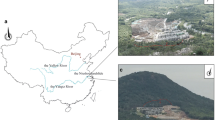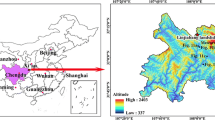Abstract
The resettlement of residents to new urban areas in the Three Gorges Reservoir region, China, has generally adopted the local resettlement method, but engineering disturbances in conjunction with heavy rainfall have contributed to landslide instability. This paper discusses the influential factors and formation mechanism of the Jinjiling landslide in Jiangdong District, Wushan County, Chongqing, China. This study concludes that the cutting and filling of slopes have led to loading of the rear edge and open cut excavation at the downhill side of landslide. More importantly, the filling of channels with surface soil has blocked the surface water discharge channel along the landslide body, thereby transforming surface water into groundwater. Therefore, under heavy rainfall, the groundwater level in the Jinjiling landslide rose substantially, resulting in large deformation in approximately August 1, 2018. After emergency treatment, including groundwater pumping, the landslide deformation slowed considerably. The rising groundwater caused by filling of the slope was the key factor influencing the landslide. Based on the deformation characteristics and formation mechanism of the landslide, comprehensive control measures referred to as the “drainage+unloading+support” scheme are proposed, and drainage should be the focus of this type of landslide protection project. The results of this study may provide a reference for similar slope engineering projects.













Similar content being viewed by others
References
Cao CS, Wu SR, Pan M, Liang CY (2016) Mechanism research on artificial slope cutting-induced loess landslide. Rock Soil Mech 37(4):1049–1060 (In Chinese)
Chai B, Yin KL, Du J, Xiao LL (2013) Correlation between incompetent beds and slope deformation at Badong town in the Three Gorges Reservoir, China. Environ Earth Sci 69:209–223
Cong L, Hu XL (2017) Triaxial rheological property of sandstone under low confining pressure. Eng Geol 231:45–55
Cruden DM, Martin CD (2006) A century of risk management at the Frank Slide, Canada, The Geological Society of London. IAEG, Nottingham
Cruden DM, Varnes DJ (1996) Landslide types and processes. In: Turner AK, Schuster RL (eds) Landslides investigation and mitigation. Transportation research board, US National Research Council, special report 247, Washington DC, Chapter 3, pp. 36–75
Dai FC, Deng JH, Tham LG, Law KT, Lee CF (2004) A large landslide in Zigui County, Three Gorges area. Can Geotech J 41:1233–1240
Deng QL, Fu M, Ren XW, Liu FZ, Tang HM (2017) Precedent long-term gravitational deformation of large scale landslides in the Three Gorges Reservoir area, China. Eng Geol 221:170–183
Fan XM, Xu Q, Zhang ZY (2008) Study on genetic mechanism of translational landslide. Chin J Rock Mech Eng S (2):3753–3759 (In Chinese)
Huang BL, Yin YP, Liu GN, Wang SC, Chen XT, Huo ZT (2012) Analysis of waves generated by Gongjiafang landslide in Wu Gorge, Three Gorges Reservoir, on November 23, 2008. Landslides 9:395–405
Hungr O, Leroueil S, Picarelli L (2014) The Varnes classification of landslide types, an update. Landslides 11:167–194
Ibañez JP, Hatzor YH (2018) Rapid sliding and friction degradation: lessons from the catastrophic Vajont landslide. Eng Geol 244:96–106
Lepore C, Kamal SA, Shanahan P, Bras RL (2012) Rainfall-induced landslide susceptibility zonation of Puerto Rico. Environ Earth Sci 66:1667–1681
Müller L (1987) The vajont castrophe-a personal review. Eng Geol 24:423–444
Rudolph T, Coldewey WG (2008) Implications of earthquakes on the stability of tailings dams. http://www.imwa.info/docs/imwa_2008/IMWA2008_025_Rudolph.pdf. Accessed 21 Jan 2019
Semenza E, Ghirotti M (2000) History of the 1963 Vaiont slide: the importance of geological factors. Bull Eng Geol Environ 59:87–97
Song K, Wang FW, Yi QL, Lu SQ (2018) Landslide deformation behavior influenced by water level fluctuations of the Three Gorges Reservoir (China). Eng Geol 247:58–68
Tang HM, Li CD, Hu XL, Wang LQ, Robert C, Su AJ, Wu YP, Xiong CR (2015) Deformation response of the Huangtupo landslide to rainfall and the changing levels of the Three Gorges Reservoir. Bull Eng Geol Environ 74:933–942
Wang FW, Zhang YM, Huo ZT, Tatsunori M, Huang BL (2004) The July 14, 2003 Qianjiangping landslide, Three Gorges Reservoir, China. Landslides 1:157–162
Wang T, Wu SR, Shi JS, Xin P, Shi L (2013) A comparative study of typical engineering landslide disasters both in China and abroad. Geol Bull China 32(12):1881–1899 (In Chinese)
Wang XG, Yin YP, Wang JD, Lian BQ, Qiu HJ, Gu TF (2018) A nonstationary parameter model for the sandstone creep tests. Landslides 15:1377–1389
Wang LQ, Yin YP, Huang BL, Zhang ZH, Wei YJ (2019) Formation and characteristics of Guang’an village landslide in Wuxi, Chongqing, China. Landslides 16(1):127–138
Wen BP, Aydin A, Duzgoren-Aydin NS, Li YR, Chen HY, Xiao SD (2007) Residual strength of slip zones of large landslides in the Three Gorges area, China. Eng Geol 93:82–98
Wichter L (2007) Stabilisation of old lignite pit dumps in Eastern Germany. Bull Eng Geol Environ 66:45–51
Xia M, Ren GM, Ma XL (2013) Deformation and mechanism of landslide influenced by the effects of reservoir water and rainfall, Three Gorges, China. Nat Hazards 68:467–482
Xu GL, Li WN, Yu Z, Ma XH, Yu ZZ (2015) The 2 September 2014 Shanshucao landslide, Three Gorges Reservoir, China. Landslides 12:1169–1178
Xu Q, Liu HX, Ran JX, Li WH, Sun X (2016) Field monitoring of groundwater responses to heavy rainfalls and the early warning of the Kualiangzi landslide in Sichuan Basin, southwestern China. Landslides 13:1555–1570
Yin YP (2005) Human-cutting slope structure and failure pattern at the Three Gorges Reservoir. J Eng Geol 13(2):145–154 (In Chinese)
Yin YP, Sun P, Zhang M, Li B (2011) Mechanism on apparent dip sliding of oblique inclined bedding rockslide at Jiweishan, Chongqing, China. Landslides 8:49–65
Funding
This study was supported by the National Key R&D Program (ID: 2018YFC1504803), the Geological Hazard Prevention and Control Project for Follow-up Work of the Three Gorges (ID: 000121 2019C C60 001 and 2018102849), and the Project from China Geological Survey (DD20190637).
Author information
Authors and Affiliations
Corresponding author
Rights and permissions
About this article
Cite this article
Yan, G., Yin, Y., Huang, B. et al. Formation mechanism and characteristics of the Jinjiling landslide in Wushan in the Three Gorges Reservoir region, China. Landslides 16, 2087–2101 (2019). https://doi.org/10.1007/s10346-019-01234-3
Received:
Accepted:
Published:
Issue Date:
DOI: https://doi.org/10.1007/s10346-019-01234-3




